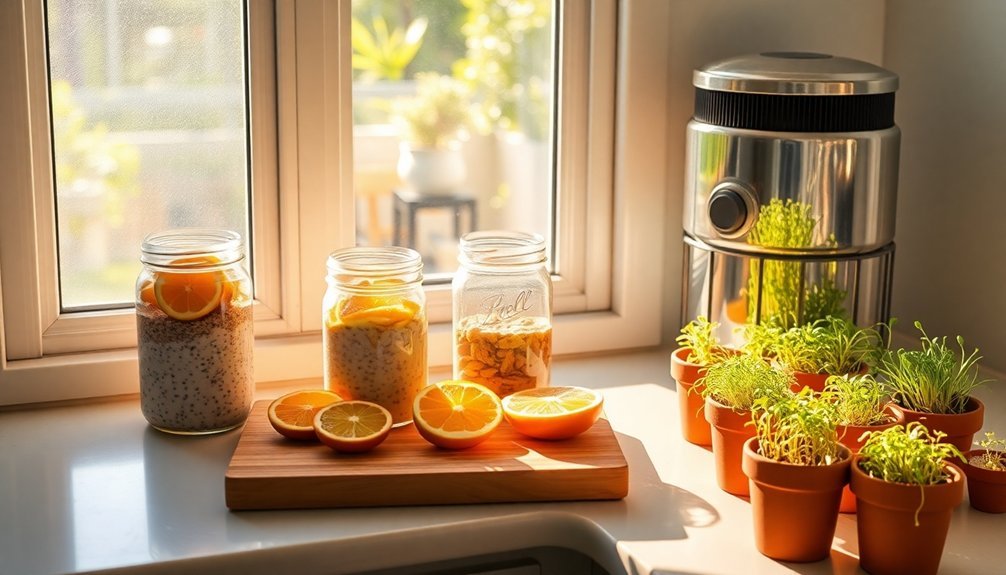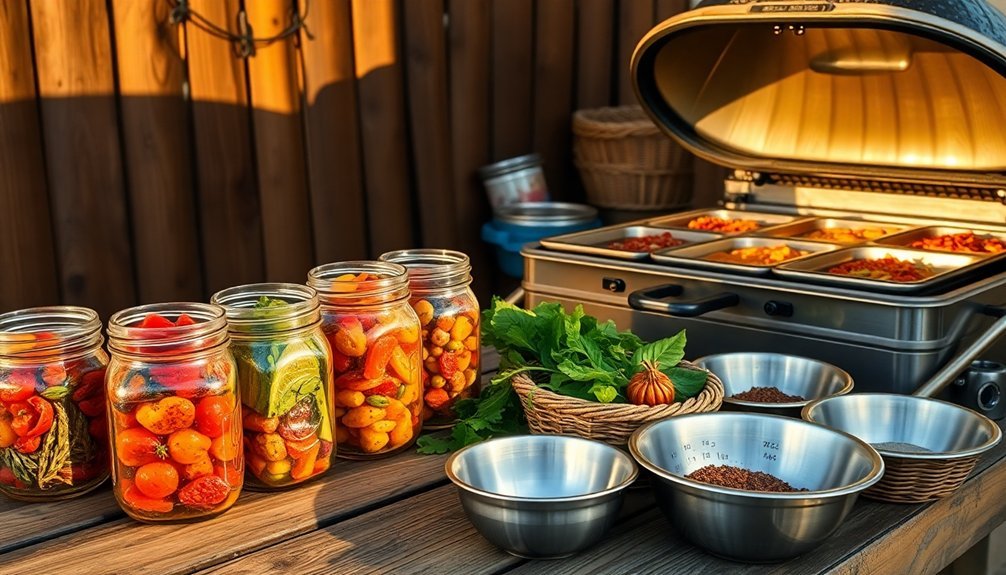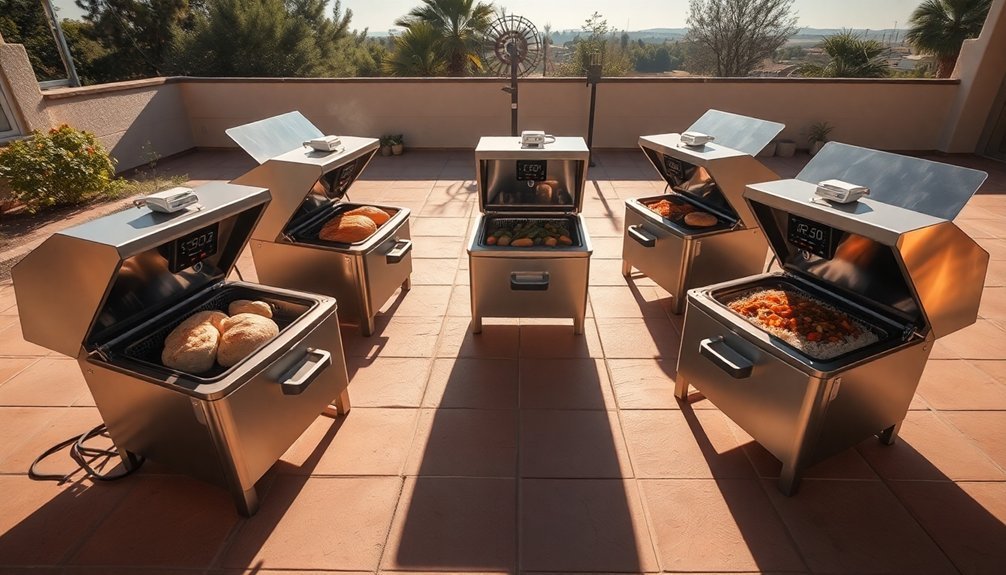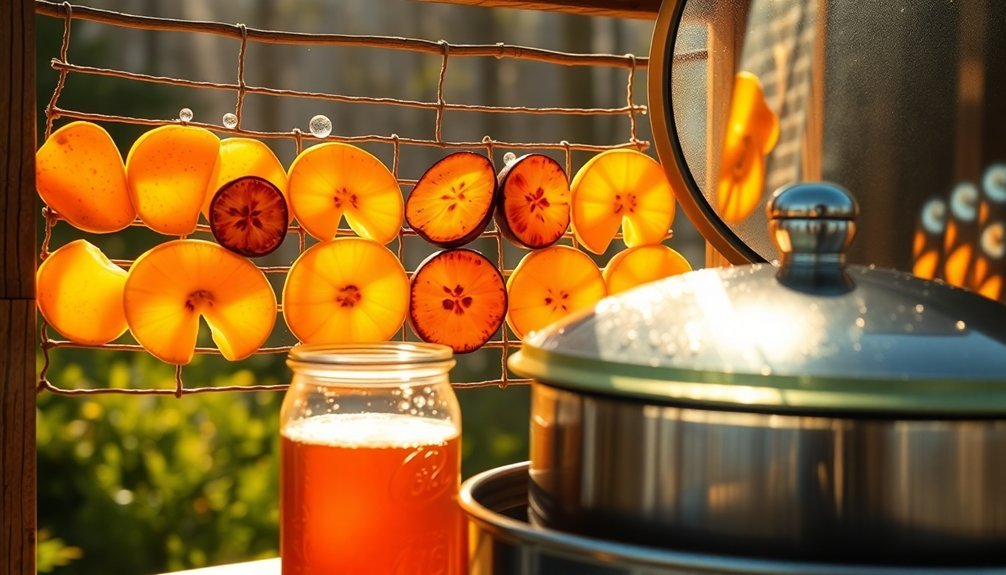You'll save hours when solar cooking by following these proven strategies. Start your day by preheating your solar oven early, around 9 AM, while prepping ingredients in bulk. Position your cooker in the strongest sunlight between 10 AM and 2 PM, using dark-colored pots to enhance heat absorption. Make the most of peak sun hours by batch cooking multiple dishes simultaneously, focusing on longer-cooking items first. Choose quick-cooking recipes like nachos or solar s'mores for efficient meal planning. Organize your cooking schedule with precise timing for different dishes, rotating the oven every 20 minutes for even heating. These fundamental techniques will reveal your solar kitchen's full potential.
Early Morning Food Prep

While the sun rises early in the morning, you'll want to make the most of those first rays by preparing your solar cooking setup right away.
Start by positioning your solar oven in direct sunlight between 9:00 and 10:00 AM to achieve ideal preheating.
You can maximize your morning efficiency by layering ingredients for a breakfast casserole while the oven warms up.
Mix eggs with milk and seasonings, then pour them over pre-arranged layers of hash browns, sausage, and cheese in a solar-safe pot.
Using a Mini SunFlair oven, your breakfast casserole will need about 2.5 hours to cook thoroughly at 82°F.
As your casserole cooks for the next 1.5 hours, use this time to prep other ingredients in bulk.
Chop vegetables, cook grains, or prepare proteins for future meals.
Remember to check the weather forecast and adjust your cooking plans accordingly, ensuring you'll have enough sunlight to complete your dishes.
Strategic Solar Cooker Placement
Three key factors determine successful solar cooking: location, timing, and positioning.
You'll want to set up your cooker between 10:00 am and 2:00 pm when the sun's rays are strongest, with 11:00 am to 3:00 pm being ideal for most cooking tasks.
Choose a flat, stable surface in full sunlight, away from shadows. If it's windy, secure your cooker with stones or bricks. Using a dark-colored cooking pot will maximize heat absorption and reduce cooking time significantly.
For parabolic cookers, point the umbrella directly at the sun, and verify your pot sits precisely at the focal point. With panel cookers, position the front flap to reflect sunlight onto your food.
Remember to adjust your cooker's angle throughout the day to track the sun's movement. This is especially important during winter months when daylight hours are shorter and the sun's path changes more frequently.
Batch Cooking for Solar Meals

Since solar cooking requires careful timing, batch cooking helps you maximize the prime sunlight hours between 11:00 AM and 3:00 PM. You'll want to prepare ingredients in bulk and use multiple solar cookers simultaneously for different dishes. Using clear, lighter cookware may increase overall cooking duration.
| Food Type | Batch Size | Cooking Time |
|---|---|---|
| Grains | 4-6 cups dry | 2-3 hours |
| Vegetables | 6-8 cups chopped | 1-2 hours |
| Meats | 3-4 pounds | 3-4 hours |
| Bread/Desserts | 2-3 loaves/items | 1.5-2 hours |
Plan your batches strategically by starting with foods that take longer to cook, like meats and grains. While these are cooking, you can prep your vegetables and desserts. Don't forget to use your thermometer to verify each batch reaches safe temperatures, and store partially cooked items in the refrigerator to finish the next day if needed.
Quick Solar Recipe Selection
Looking for quick solar recipes that maximize your cooking time in the sun? You'll find nachos are your fastest option, cooking in just 20-30 minutes on a 95-degree day. Simply layer tortilla chips with cheese in a pie pan and let the sun do its work.
For 40-minute recipes, try s'mores using graham crackers and marshmallows, or whip up English muffin pizzas with your favorite toppings. You can prepare a delicious cheese crisp with tortillas using the same cooking time.
If you're cooking breakfast, opt for an open-faced omelet that's ready in 25 minutes. For a heartier meal, tandoori chicken takes just 30 minutes after marinating.
Remember to use pie tins or pans with cooking bags to trap heat effectively. You can also create smaller portions using pot pie-sized pans, perfect for individual servings.
Timing Multiple Solar Dishes

When preparing multiple dishes in your solar oven, planning becomes essential to guarantee everything finishes at the right time. You'll need to strategically position your cookware and monitor cooking temperatures carefully using an oven thermometer.
| Dish Type | Start Time | Position |
|---|---|---|
| Meats | 10:00 AM | Bottom |
| Vegetables | 11:30 AM | Middle |
| Rice/Grains | 12:00 PM | Top |
| Soups | 10:30 AM | Middle |
| Desserts | 1:00 PM | Top |
Use a Lazy Susan to rotate your oven every 20 minutes, ensuring consistent heat distribution. Place darker, thinner pots on the bottom shelf where they'll receive maximum heat exposure. You can stack multiple dishes using high-temperature oven bags to maintain separate cooking environments. Remember to adjust cooking times on cloudy days and rely on meat thermometers rather than timers to check doneness.
Frequently Asked Questions
Can Solar Cooking Be Effective on Partially Cloudy Days?
Yes, you can still cook effectively on partially cloudy days using solar ovens. They're insulated and can collect heat even with reduced sunlight, though you'll need longer cooking times and should monitor temperatures closely.
What Materials Are Safest for Solar Cooking Containers?
You'll find dark, food-grade metal containers are safest for solar cooking. Choose graniteware, cast iron, or dark nonstick pans. Always use heat-resistant materials and avoid containers that might release harmful chemicals when heated.
How Do I Prevent Food From Drying Out During Solar Cooking?
You'll prevent food from drying out by using tight-fitting lids, reducing recipe liquids by ¼ to ½ cup, adding sauces or broths, and using dark cookware with covers. Monitor moisture levels throughout cooking time.
Can I Use Solar Cooking Methods During Winter Months?
Yes, you can solar cook during winter months if there's bright sunlight. You'll need a well-insulated cooker, regular sun tracking between 11am-3pm, and slightly longer cooking times due to colder temperatures.
What Backup Options Should I Have When Solar Cooking Fails?
You'll need reliable backup options like portable battery packs, propane stoves, or indoor appliances. Keep a power bank handy for hybrid solar ovens, and don't forget traditional options like outdoor grills or campfires.
In Summary
You'll find these time-saving solar cooking tips transform your outdoor meal preparation. By prepping ingredients early, positioning your solar cooker strategically, batch cooking when possible, choosing quick-cooking recipes, and coordinating multiple dishes effectively, you've mastered the art of efficient sun-based cooking. Make the most of daylight hours and enjoy delicious solar-cooked meals without spending all day monitoring your food.





Leave a Reply